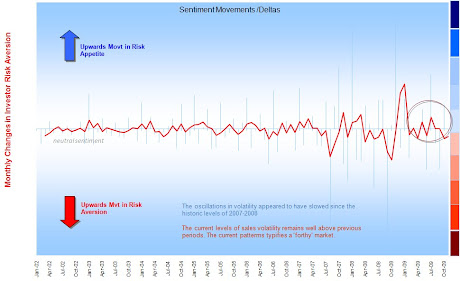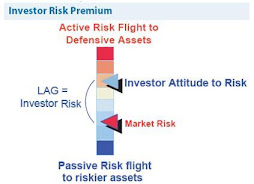The original question: What should regulators do if they cannot predict the next black swan?
http://www.linkedin.com/groupAnswers?viewQuestionAndAnswers=&gid=80474&discussionID=9531762&commentID=8993665&report%2Esuccess=8ULbKyXO6NDvmoK7o030UNOYGZKrvdhBhypZ_w8EpQrrQI-BBjkmxwkEOwBjLE28YyDIxcyEO7_TA_giuRN#commentID_8993665
In Taleb-land I was thinking in an anti-knowledge perspective (say for risk management) - what can regulators and risk functions do when confronting reform following the latest market events? I made reference to Michael Gambanelli of LSE and Y/Zen - he recommended less regulation not more.
Safe to say the discussion went on tangents and drew on and on - lots of models were discussed, challenged and debated. Eventually all lo-fi forms of MPT*-based analysis was thrown out.*(Modern or Markowitz Portfolio Theory).
One of the last posts: "Ok, how about this. If you assume a constant variance, and variance is actually time varying, you get a chance to see how much you can lose when variance spikes instantaneously to a very large number that you did not expect, taking the covariance matrix with it. I think this is the very definition of 'meaningless' in the risk management business. You blow up and you don't know it - your numbers don't tell you that you can EVER blow up. How bad is that?
What is beta? Another meaningless and static measure that doesn't capture the complexity of a multifractal random process that is the stock market.
You are assuming a Gaussian world, whereas the world is definitely not. Use the right measures for the right world, or else get ready to blow up when you least expect it. This should be one of the big lessons from this crisis, imho."
I like Taleb's book and his reference to the 'GIF'... (Great Intellectual Fraud) that is the 'bell curve or Gaussian' and sets the tone for his Black Swan book. To that end I agree that few models rarely allow for enough his 'extremistan'.. and tha complex models are perhaps best consigned for the bin but simpler models still hold value. We'll talk more about the bell-curve soon.
[Gaussian is basically the guy who invented the law of large numbers (over time results form a bell shaped histogram), which is described as 'mediocrestan' - the assumption of mediocre/average events. 'Extremistan' is then Taleb's opposite: i.e. unexpected 'extreme' events like the credit crunch but also more often things like war, political coups etc.]
I recommend reading The Black Swan: The Impact of the Highly Improbable by Nassim Nicholas Taleb, perhaps alongside Market Prophets: Can Forecasters Predict the Financial Future? by David Stamp.
All this chat took me back to the analysis I was running between 2006-2008. This included the correlations of approx 6500 mutual funds as well as the tracking of money flows in a sample of about 50,000 mutual funds across the globe. My only point was that because MPT sets out some expected outcomes - numbers were already popping up unexpected well before the credit crunch kicked in. Of course we couldn't predict the future or what would happen next but we did take action - from this I am now convinced that risk is actually a constant in size; expanding and contracting for liquidity/information, and kinetic in that it changes from active to passive risk and back again. Interestingly MSCI Barra's model did flag the risk well before Q3 2007 iirc.
No, my biggest problem in 2006 was that no one in the firm wanted to talk about 'risk' when the 1, 3 and 5 year returns looked so marketable - the same was true across the industry, as investors were lured in on past performance. This I would come to call 'passive' risk.
Risk doesn't go away just because it's effect is variable; it's probably not a black swan either since the potential for calamity seems always present by the fact we continue to invest, powered along by herding and sentiment. What changes is information - the media mask and escalate risk variablly against other stories to sell news.
I read a Talinn Institute research paper into noise 'kernels' and non-MPT dispersions around 2007, which combined with the MSCI Barra research, and that pointed me in a direction. Kernels are basically clusters of positive and negative performance returns. Traditional MPT states an expected distribution of returns; the Talinn Institute and Taleb disagree. It was a bit heavy but made me realise that performance can come in all shapes and sizes.
I'll post up the concept proper shortly - what I call 'mutual momentum'.. for me it's a simple tool for the contrarian investor - a way to invest/time based on herding patterns, to manage 'passive risk' resulting. Handily it also doubles up as a simple proxy/index of investor sentiment.
In essence - yes we should be aware that extreme events cannot be predicted easily; while robust (simple) triggers can be used practically to align your portfolio. I realised that by only looking at performance regressions; and any models thereon, we were only looking at some of the information critically needed to make contrarian calls.
Appreciate this is all a bit dense for the first post; we'll break this down into much more compact investment ideas going forward. Promise.




Nick Gogerty wrote on his forum: "the assumption of stable co-variance or a bounded historical representative co-variance in the historical data set is the weakness of the most modern portfolio theory approaches." here is a good video of Taleb: http://fora.tv/2008/02/04/Nassim_Nicholas_Taleb_A_Crazier_Future
ReplyDelete